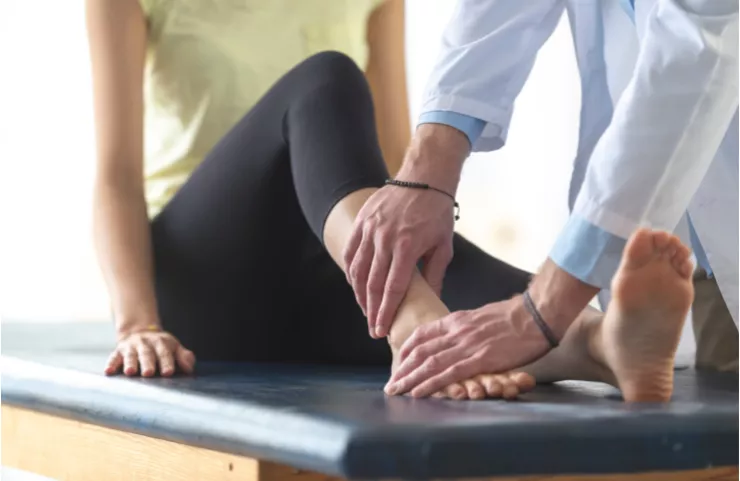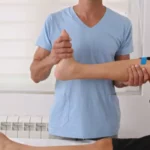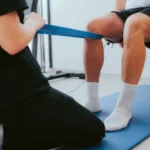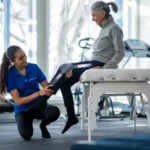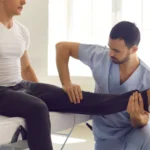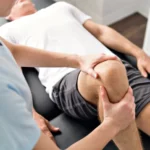Ankle Sprain Rehab Physiotherapist In Thane
Overview
Ankle sprains are among the most common injuries we treat at our clinic in Thane West. They often seem minor at first, a twist, a stumble, a sharp pain, but left untreated or poorly managed, they can lead to long-term instability, recurring injuries, and chronic discomfort. Over the years, we’ve seen how a well-structured rehab plan can make all the difference. Our goal isn’t just to reduce pain. It’s to restore movement, rebuild strength, and help people return to the activities they love.
What Really Happens During an Ankle Sprain?
The ankle joint is a beautifully complex structure, built for both stability and flexibility. It allows us to walk, run, jump, and pivot with ease. But when the foot rolls inward, often during sports, uneven terrain, or a misstep, the ligaments on the outside of the ankle can stretch or tear. We classify sprains into three grades: Grade I involves mild stretching, Grade II includes partial tears, and Grade III is a complete rupture. Each grade presents differently, and each requires a tailored approach. That’s why we begin every case with a thorough clinical evaluation, sometimes supported by imaging. Understanding the extent of ligament damage helps us design a rehab plan that’s both safe and effective
Why Physiotherapy Is Essential for Recovery
Rest alone doesn’t heal an ankle sprain. In fact, prolonged inactivity can lead to stiffness, weakness, and poor balance. That’s where physiotherapy plays a vital role. A skilled ankle sprain rehab physiotherapist in Thane can guide the healing process, prevent complications, and rebuild strength in a structured way. Rehab isn’t just about exercises, it’s about retraining the body to move confidently again. We focus on pain control, restoring range of motion, strengthening key muscles, and improving proprioception. With the right guidance, recovery becomes faster, smoother, and far more complete. We’ve seen patients go from limping to sprinting in just a few weeks with consistent, targeted therapy.
Stages of Recovery
Recovery from an ankle sprain typically unfolds in phases. In the first week, we focus on pain and swelling control using rest, ice, compression, and elevation. By week two, we introduce gentle mobility exercises and begin light strengthening. Weeks three to five are about rebuilding stability, through balance drills, resistance work, and gait retraining. From week six onward, we tailor rehab to specific goals, whether that’s returning to sport, work, or daily routines. Each stage builds on the last, and we adjust the plan based on progress. Our goal is not just healing, but resilience, so the ankle can handle future challenges with ease.
What Happens During a Rehab Session?
Every rehab session at our clinic is designed to be purposeful and progressive. We begin with a quick check-in to assess symptoms and track improvements. Then we move into manual therapy, mobilizing joints, releasing tight tissues, and improving circulation. Next comes exercise therapy, where we guide patients through strength, balance, and coordination drills. We use tools like resistance bands, balance boards, and gait analysis to fine-tune movements. Education is a key part of every session, we explain what’s happening, what to expect next, and how to manage symptoms at home. Each visit is a step forward, building toward full recovery.
Home Care Tips to Support Recovery
While in-clinic sessions are crucial, what happens between them matters just as much. We equip patients with simple, effective home routines to support healing. In the early phase, we recommend the RICE protocol and gentle ankle pumps to maintain circulation. As recovery progresses, we introduce towel scrunches, toe curls, and single-leg balance drills. Resistance exercises using therabands help strengthen key muscles. We also guide patients on safe walking patterns, footwear choices, and activity pacing. Our handouts and video demos ensure these exercises are done correctly. With consistent home care, recovery becomes faster and more sustainable.
Preventing Future Ankle Injuries
Once someone has sprained an ankle, the risk of recurrence increases, unless we address the underlying issues. That’s why prevention is a core part of our rehab philosophy. We assess and strengthen weak links like the hips and core, which often contribute to poor foot control. Balance training improves proprioception, helping the body react quickly to uneven surfaces. We also provide guidance on footwear, orthotics, and sport-specific drills. For athletes, we simulate game-like movements to build resilience. Prevention isn’t just about avoiding pain, it’s about empowering people to move freely and confidently, without fear of injury.
Why Choose Us for Ankle Sprain Rehab in Thane
We’re not just treating an ankle, we’re restoring a lifestyle. With over 400 joint surgeries a year and international training across the UK, Germany, and Portugal, we bring deep orthopedic insight to every case. Our in-house physiotherapy team works hand-in-hand with us, ensuring seamless care and faster recovery. We listen, adapt, and walk the journey together. From dry needling to neuromuscular re-education, we use modern techniques that work. Most importantly, we prioritize ethical, patient-first care, no shortcuts, no over-treatment, just honest, effective healing. That’s why patients trust us with their recovery.
Understanding the Ankle Joint
Before we dive deeper into rehab strategies, it’s important to understand the anatomy of the ankle joint. The ankle isn’t just one joint, it’s a complex region where the tibia, fibula, and talus bones meet to allow movement and stability. This area includes the talocrural joint, subtalar joint, and inferior tibiofibular joint, each contributing to the foot’s ability to flex, rotate, and absorb impact. For a detailed breakdown of this anatomy, we often refer patients to the Ankle overview on Wikipedia, which offers clear visuals and terminology. Knowing how these structures interact helps us explain why certain sprains affect balance, gait, or long-term joint health.
Evidence-Based Rehab Exercises for Ankle Sprains
Rehabilitation isn’t guesswork, it’s a science. At our clinic, we rely on evidence-based protocols to guide recovery from ankle sprains. These include progressive loading, proprioceptive training, and strength conditioning tailored to the stage of healing. For those interested in the clinical reasoning behind these exercises, the Mayo Clinic’s treatment guide for sprained ankles offers a reliable overview. It outlines how imaging, physical exams, and structured rehab can prevent complications like chronic instability or tendon overload. We use similar principles, adapted to each patient’s lifestyle and goals.
Proprioception
One of the most overlooked aspects of ankle rehab is proprioception, the body’s ability to sense joint position and movement. After a sprain, this sense often becomes impaired, leading to poor balance and a higher risk of re-injury. That’s why we include proprioceptive drills in every rehab plan, from single-leg stances to dynamic balance challenges. For those curious about the science behind it, Physiopedia’s article on ankle proprioception explains how sensory receptors and neuromuscular feedback loops help coordinate movement. By retraining these systems, we help patients regain not just strength, but confidence in every step.
The Role of Gait Retraining in Ankle Sprain Recovery
After an ankle sprain, even simple walking patterns can become disrupted. People often compensate unconsciously, placing more weight on the uninjured side, shortening their stride, or avoiding full foot contact. Over time, these habits can lead to knee, hip, or lower back strain. That’s why gait retraining is a key part of our rehab process. We assess walking mechanics in detail and use cues, drills, and feedback tools to restore symmetry and fluidity. Whether someone is returning to daily errands or competitive sport, proper gait ensures that movement is efficient, safe, and pain-free. It’s not just about walking again, it’s about walking well.
How We Use Manual Therapy to Accelerate Healing
Manual therapy is more than just hands-on care, it’s a precise, therapeutic technique that helps reduce pain, improve mobility, and stimulate healing. At our clinic, we use joint mobilizations, soft tissue release, and targeted manipulations to address stiffness and restore function. For ankle sprains, this might involve freeing up the subtalar joint, easing tension in the peroneal muscles, or improving talocrural glide. These techniques complement exercise therapy and often speed up progress. We’ve found that combining manual therapy with active rehab leads to better outcomes, especially in cases where swelling or guarding limits movement early on.
Customizing Rehab for Athletes and Active Professionals
Not all ankle sprains are the same, and neither are the people who experience them. Athletes, dancers, and active professionals often need more than basic rehab. They require sport-specific conditioning, explosive movement retraining, and psychological readiness to return to high-demand activities. That’s why we customize our protocols based on performance goals. For runners, we focus on stride mechanics and impact absorption. For footballers, we simulate lateral cuts and pivot drills. For working professionals, we ensure stability during long hours of standing or commuting. Rehab isn’t just about healing, it’s about restoring peak function in real-world scenarios.
The Psychological Side of Injury and Recovery
Ankle sprains may seem physical, but the emotional impact is real. We’ve seen patients struggle with fear of re-injury, frustration over lost mobility, and anxiety about returning to sport or work. That’s why we address the psychological side of recovery with equal care. We encourage open conversations, set realistic goals, and celebrate small wins along the way. Our team provides reassurance, clarity, and motivation, helping patients rebuild not just their ankle, but their confidence. Recovery is a journey, and mindset plays a powerful role. When people feel supported and understood, they heal faster and move forward stronger.
FAQs About Ankle Sprain Rehab
Q.1: What if someone has other joint issues along with the ankle sprain?
Ans. We take a holistic approach, evaluating the entire kinetic chain to ensure rehab supports overall joint health and movement.
Q.2: Is surgery ever needed for ankle sprains?
Ans. Rarely. Most sprains heal with structured rehab, but in cases of complete ligament rupture or persistent instability, we evaluate surgical options.
Q.3: When should someone start rehab after a sprain?
Ans. Ideally within the first few days. Early intervention leads to faster healing and reduces the risk of complications.
Conclusion
An ankle sprain may seem like a small setback, but we’ve seen how it can ripple into long-term discomfort, instability, and hesitation in movement. At our clinic in Thane West, we treat every sprain with the seriousness it deserves, not just to heal the ligament, but to restore full-body confidence. Our integrated orthopedic and physiotherapy approach ensures that recovery is not only faster but also more complete. We don’t believe in shortcuts or generic protocols. We believe in listening, adapting, and walking the rehab journey together. Whether someone is an athlete, a professional, or simply wants to move without pain, we’re here to help rebuild strength, stability, and trust in every step. Because movement isn’t just physical, it’s freedom, and it’s worth protecting.
Visit us at https://acktivortho.com | Call us at +91 99670 63812 to book a consultation
Ankle Sprain Rehab Physiotherapist In Thane Ankle Sprain Rehab Physiotherapist In Thane Ankle Sprain Rehab Physiotherapist In Thane Ankle Sprain Rehab Physiotherapist In Thane Ankle Sprain Rehab Physiotherapist In Thane Ankle Sprain Rehab Physiotherapist In Thane Ankle Sprain Rehab Physiotherapist In Thane Ankle Sprain Rehab Physiotherapist In Thane Ankle Sprain Rehab Physiotherapist In Thane Ankle Sprain Rehab Physiotherapist In Thane Ankle Sprain Rehab Physiotherapist In Thane Ankle Sprain Rehab Physiotherapist In Thane Ankle Sprain Rehab Physiotherapist In Thane Ankle Sprain Rehab Physiotherapist In Thane Ankle Sprain Rehab Physiotherapist In Thane Ankle Sprain Rehab Physiotherapist In Thane Ankle Sprain Rehab Physiotherapist In Thane Ankle Sprain Rehab Physiotherapist In Thane Ankle Sprain Rehab Physiotherapist In Thane Ankle Sprain Rehab Physiotherapist In Thane
